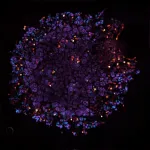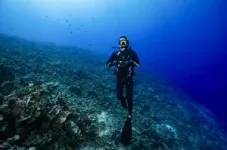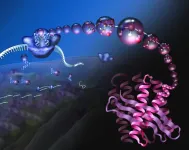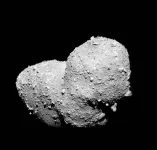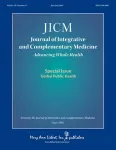(Press-News.org)
To help patients in need of transplants, artificial kidneys would have to function like their natural counterparts, but they wouldn’t necessarily have to look like them. With a new $1 million prize from the Kidney Innovation Accelerator, or KidneyX, a team of USC Stem Cell scientists led by Nils Lindström in collaboration with Leonardo Morsut are on a quest to build a kidney that resembles the real thing in function, but not in form.
“Nature has taught us that kidneys can come in an astounding diversity of forms,” said Lindström, who is the principal investigator for the grant and an assistant professor of stem cell biology and regenerative medicine at the Keck School of Medicine of USC. “Whereas humans have two big kidneys, one of our largest mammalian cousins, the whale, has numerous kidneys working together and resembling a bunch of grapes. We aspire to follow a similar design in building an artificial kidney using human stem cells.”
With the ultimate goal of providing functional artificial organs for the more than 100,000 patients awaiting kidney transplants, Lindström and his incoming PhD student Connor Fausto teamed up with Morsut and his postdoctoral trainee Fokion Glykofrydis.
To this collaboration, the Lindström lab members will contribute a detailed understanding of how the human kidney develops before birth. Following these fundamental developmental principles, they’ve already succeeded in using stem cells to generate and assemble up to 500 artificial kidney filtering tubes, called nephrons, into pea-size discs called organoids. And even though the scientists cannot yet assemble one million nephrons, which is the number found in a single adult human kidney, whale anatomy demonstrates that lots of little kidneys can work equally well as two big ones.
“Just one thousand of these kidney organoids would contain 400,000 nephrons and amount to approximately half the number of nephrons found in each of your kidneys,” said Lindström.
However, for these organoids to functionally compensate for a failing human kidney, they need to connect them to the blood supply as well as to a urine drainage system. This is because nephrons function to filter the blood, reabsorb needed nutrients and fluids, and excrete unneeded ones into the bladder as urine.
This is where the Morsut lab members bring in their expertise in synthetic biology, a field dedicated to redesigning biological systems. The Morsut lab has engineered genetic circuits that can instruct human cells to assemble into specific patterns and shapes, such as the tube-like structures needed to connect the kidney organoids to blood input and urine output.
“When growing kidney organoids in a lab, they need a little extra coaxing to develop all of the necessary functional components such as the drainage system for collecting urine,” said Morsut, a co-investigator on the grant and an assistant professor of stem cell biology and regenerative medicine, and biomedical engineering at USC. “Our engineered genetic circuits give them this extra nudge and allow us to control their architecture with a precision that we can’t achieve in a lab environment if we rely solely on stem cells’ natural ability to self-organize.”
This unorthodox approach is precisely the type of research that KidneyX is designed to support. As a public-private partnership between the US Department of Health and Human Services (HSS) and the American Society of Nephrology, KidneyX aims to accelerate innovation in the prevention, diagnosis, and treatment of kidney diseases.
“What KidneyX has recognized is that we need to think better, think bold, and think big to build artificial kidneys that are wearable or implantable,” said Lindström. “We hope our collaboration can transform our thinking about how artificial kidneys can be built and drained through synthetic cellular systems, and ultimately provide better therapeutic alternatives for patients with end-stage kidney disease.”
About Keck School of Medicine of USC
Founded in 1885, the Keck School of Medicine of USC is one of the nation’s leading medical institutions, known for innovative patient care, scientific discovery, education and community service. Medical and graduate students work closely with world-renowned faculty and receive hands-on training in one of the nation’s most diverse communities. They participate in cutting-edge research as they develop into tomorrow’s health leaders. The Keck School faculty are key participants in training of 1200 resident physicians across 70 specialty and subspecialty programs, thus playing a major role in the education of physicians practicing in Southern California.
END
Synthetic biologists have become increasingly creative in engineering yeast or bacteria to churn out useful chemicals — from fuels to fabrics and drugs — beyond the normal repertoire of microbes.
But a multi-university group of chemists has a more ambitious goal: to retool the cell's polypeptide manufacturing plants — the ribosomes that spin amino acids into protein — to generate polymer chains that are more elaborate than what can now be made in a cell or a test tube.
The $20 million research enterprise centered at the University of California, Berkeley, is ...
A new analysis provides a more complete picture of sickle cell disease mortality burden by combining disease prevalence data in different age groups and trends in overall survival when factoring in resulting secondary conditions.
When looking across all deaths, sickle cell disease is a leading cause of mortality in children under 5 years as well as in youth 5–14 years and adults 15–49 years.
Half a million babies were born with sickle cell disease in 2021, and 79% of these infants were in sub-Saharan Africa.
The largest increases ...
Billions of people around the world face water insecurity. Although there are numerous projects from governments, NGOs, and private corporations who are committed to providing safely managed water and sanitation by 2030, a new study advocates for more holistic evaluation of water, sanitation, and hygiene (WASH) interventions.
According to the study by Justin Stoler, associate professor in the University of Miami College of Arts and Sciences Department of Geography and Sustainable Development, issues ...
NEW YORK, June 13, 2023 – With the potential for artificial intelligence (AI) to create both massive disruption and great opportunity within the music industry, ASCAP — the only US PRO that operates on a not-for-profit basis — is introducing a slate of AI initiatives to help music creators navigate the future while protecting their work. These newly announced initiatives include: adoption by the ASCAP Board of Directors of a set of key ASCAP AI principles, creator education, startup incubation and policy development. Building upon ASCAP’s strong ...
Researchers have newly discovered a surprising and potentially significant reason why eating foods frequently cooked at high temperatures, such as red meat and deep-fried fare, elevates cancer risk. The alleged culprit: DNA within the food that’s been damaged by the cooking process.
As shown for the first time known to the authors, this study by Stanford scientists and their collaborators at the National Institute of Standards and Technology (NIST), the University of Maryland, and Colorado State University reveals that components of heat-marred DNA can be absorbed during digestion and incorporated into the DNA of the consumer. That uptake directly ...
Irvine, Calif., June 13, 2023 – University of California, Irvine neuroscientists probing the gene changes behind Alzheimer’s disease have developed a process of making a “meta-cell” that overcomes the challenges of studying a single cell. Their technique has already revealed important new information and can be used to study other diseases throughout the body. Details about the meta-cell – created by researchers with the UCI Institute for Memory Impairments and Neurological Disorders, known as UCI MIND – were published in the online journal Cell Press.
Technologies called transcriptomics that study sets of RNA within organisms ...
Think fast: if you’re running a race and overtake the person in second place, what position are you in? Many people instinctively respond that you’re in first place. However, upon reflection, some people realize the correct answer is that you’re now in second place: the former number-two runner slipped into third as you overtook them.
Trick questions of this kind are invaluable to cognitive scientists because they shed light on the cognitive quirks that shape our decision-making. “These aren’t just trick questions,” explained Nick Byrd, a philosopher-scientist and Intelligence Community Fellow who led the research at Stevens ...
Sodium chloride, better known as table salt, isn't exactly the type of mineral that captures the imagination of scientists. However, a smattering of tiny salt crystals discovered in a sample from an asteroid has researchers at the University of Arizona Lunar and Planetary Laboratory excited, because these crystals can only have formed in the presence of liquid water.
Even more intriguing, according to the research team, is the fact that the sample comes from an S-type asteroid, a category known to mostly lack hydrated, or water-bearing, minerals. The discovery strongly suggests ...
Tumors are not just isolated clumps of abnormal cells but are associated with more complex system known as the “tumor microenvironment” (TME). Over the past few years, research has revealed that the TME consists of a complex combination of blood vessels, connective tissue, and a matrix of extracellular proteins and molecules. Most importantly, the composition of the TME is different from that of nearby healthy tissues. In particular, the lipid and collagen contents of tumors differ from those of normal tissues, making them important potential biomarkers for diagnosing various types of ...
A special focus issue of the peer-reviewed Journal of Integrative and Complementary Medicine (JICM) on Global Public Health is a response to the Declaration of Astana, developed by the World Health Organization and UNICEF. With contributions from traditional, complementary, and integrative medicine (TCIM) scholars and thought leaders around the world, the issue showcases research and scholarship examining the opportunities and challenges that TCIM approaches offer global health to governments and health service providers seeking to fulfill ...
